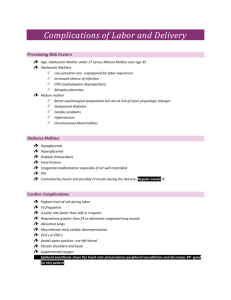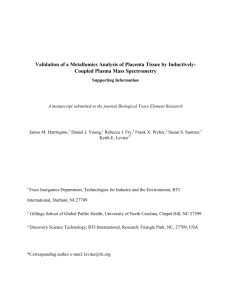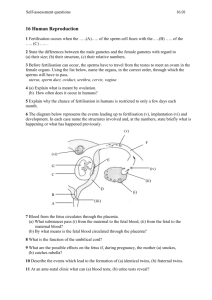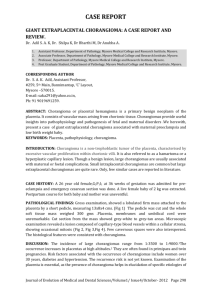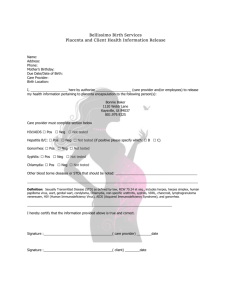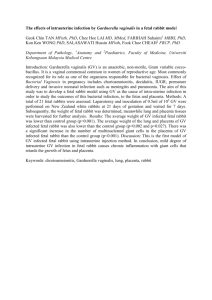44 NGF Obstet Placenta Staff
advertisement
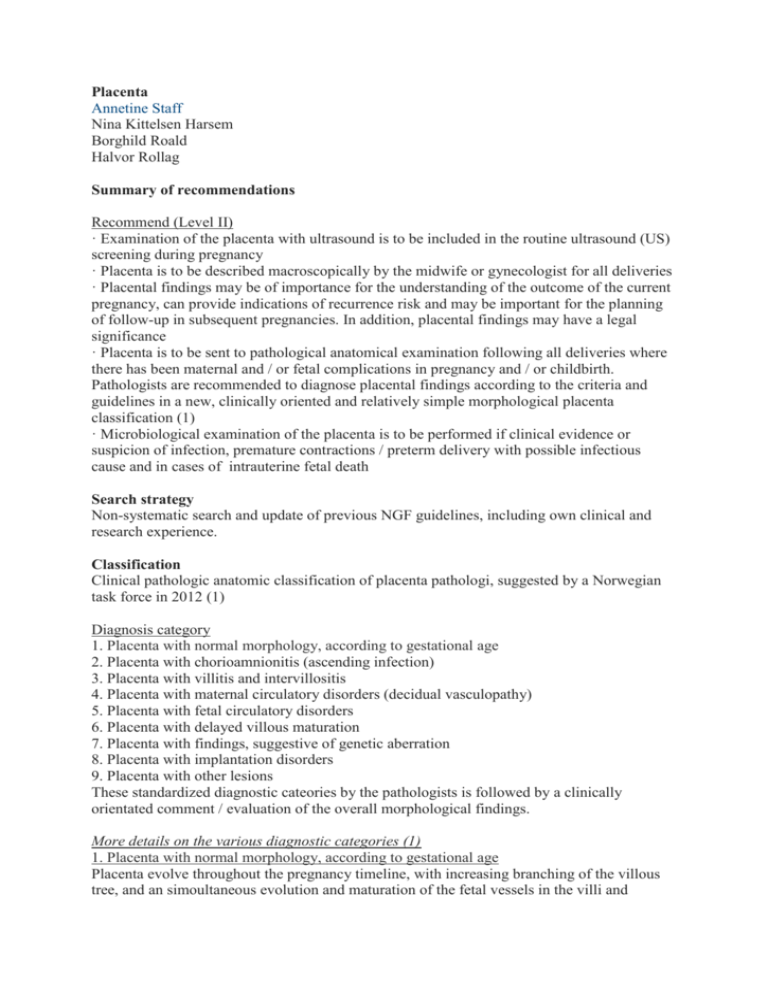
Placenta Annetine Staff Nina Kittelsen Harsem Borghild Roald Halvor Rollag Summary of recommendations Recommend (Level II) · Examination of the placenta with ultrasound is to be included in the routine ultrasound (US) screening during pregnancy · Placenta is to be described macroscopically by the midwife or gynecologist for all deliveries · Placental findings may be of importance for the understanding of the outcome of the current pregnancy, can provide indications of recurrence risk and may be important for the planning of follow-up in subsequent pregnancies. In addition, placental findings may have a legal significance · Placenta is to be sent to pathological anatomical examination following all deliveries where there has been maternal and / or fetal complications in pregnancy and / or childbirth. Pathologists are recommended to diagnose placental findings according to the criteria and guidelines in a new, clinically oriented and relatively simple morphological placenta classification (1) · Microbiological examination of the placenta is to be performed if clinical evidence or suspicion of infection, premature contractions / preterm delivery with possible infectious cause and in cases of intrauterine fetal death Search strategy Non-systematic search and update of previous NGF guidelines, including own clinical and research experience. Classification Clinical pathologic anatomic classification of placenta pathologi, suggested by a Norwegian task force in 2012 (1) Diagnosis category 1. Placenta with normal morphology, according to gestational age 2. Placenta with chorioamnionitis (ascending infection) 3. Placenta with villitis and intervillositis 4. Placenta with maternal circulatory disorders (decidual vasculopathy) 5. Placenta with fetal circulatory disorders 6. Placenta with delayed villous maturation 7. Placenta with findings, suggestive of genetic aberration 8. Placenta with implantation disorders 9. Placenta with other lesions These standardized diagnostic cateories by the pathologists is followed by a clinically orientated comment / evaluation of the overall morphological findings. More details on the various diagnostic categories (1) 1. Placenta with normal morphology, according to gestational age Placenta evolve throughout the pregnancy timeline, with increasing branching of the villous tree, and an simoultaneous evolution and maturation of the fetal vessels in the villi and changes in the villous stroma. During microscopic examination of the placenta the maturation is evaluated against gestational age and placental weight. In chorioamnionitis and maternal circulation disorders, placenta may appear hypermature. In metabolic disease such as diabetes and overweigth, delayed villous maturation may be seen ("maturation arrest"). From gestational week 37-38, some degree of ischemic changes in placenta can be observed microscopically, usually without any clinical significance in a normally large placenta (which has a large reserve capacity). 2. Placenta with chorioamnionitis Chorioamnionitis is most frequently caused by ascending infection with microorganisms from the vagina, and is usually acute. Acute chorioamnionitis will be confirmed histologically, and will be specified and graded as maternal inflammatory response and fetal inflammatory response according to international criteria. Low-grade histological chorioamnionitis does not necessarily have clinical significance. Only a few fetuses with histologically placental chorioamnionitis present with early neonatal sepsis. The percentage increases with pathogenic bacteria, e.g. group B betahemolytic streptococcus. Symptomatic intrauterine maternal infection is usually caused by endometritis (deciduitis) which may be, however rarely, associated with chorioamnionitis. Severe chorioamnionitis with fetal harm can occur without concurrent maternal fever. Maternal fever is not synonymous with infection (often seen in women with epidural). Clinical outcome for the newborn corresponds with degree of histopathological chorioamnionitis, but poorly with maternal degree of endometrial infection. Histological acute chorioamnionitis in premature deliveries may be associated with premature rupture of membranes (PROM), both as a cause for and secondary to chorioamnionitis. In chorioamnionitis, placenta may appear perfectly normal macroscopically, possibly with a non-tanslucent surface with opaque membranes. The membranes can also be discolored in green- yellow, have a purulent exudate and stink. Meconium-staining of membranes and the fetal placental surface can macroscopically be difficult to distinguish from chorioamnionitis and can be seen if the fetus in utero has passed meconium. Such discoloration is rare before week 30, but common in postterm pregnancies. The fetal surface of the placenta, membranes and umbilical cord can be greenish discolored, edematous and slimy, or darker when there is a longer duration of the mekonium exposure. Microscopically, meconium staining is diagnosed by identifying meconium macrophages, which arenmacrophages with phagocytized meconium (yellow-brown granular material) in membranes and in the chorion. 3. Placenta with villitis and intervillositis Chronic villitis is diagnosed microscopically by the presence of chronic inflammatory infiltrate (lymphocytes and / or plasma cells and macrophages) and focal fibrosis in the placental villous tissue, possibly combined with intervillositis (inflammatory cells in the intervillous room). Chronic villitis and intervillositis cannot be seen macroscopically. Microscopically, villitis is divided into two general groups: 1) those with proven infectious aetiology (blood-borne / transplacental) infection from mother (eg CMV, herpes simplex, syphilis, parvovirus B19 or toxoplasma) and 2) those of unknown etiology (villitis with unknown etiology; VUE). VUE may be due to a non-identified infection or alternatively an immune reaction, a kind of "rejection". Immunohistochemical sub classification of cells in the villitis infiltrates may be of diagnostic help. Villitis and intervillositis are divided histologically by intensity and extension into high grade and low grade. The high grade villitis often have a risk for recurrence. Chronic villitis is found in 5-15% of placentae and pregnancies complicated by fetal growth restriction and intrauterine death have an increased incidence, up to 34%. (1) 4. Placenta with maternal circulation disorders (decidual vasculopathy / maternal vessel pathology) Maternal vessel pathology is the most frequent cause of placental insufficiency and morphological placental changes. The maternal vessel pathology may be related to preexisting maternal vascular disease such as hypertension, immunological disease, thrombophilia and vasculitis or it can represent new onset, pregnancy related vessel pathology such as in preeclampsia. The maternal vessel pathology may also be related to local uterine conditions e.g. placentation in areas with poor decidua or myomas. Microscopic evidence of maternally induced ischemia includes increased syncytial sprouting, intervillous fibrin deposition, distal villous hypoplasia and villous infarcts. Only infarcts can be seen macroscopically and are due subtotal or total stenosis/ occlusion of maternal (decidual) vessels. A normal placenta has large reserve capacity. In maternal vessel pathology the placenta is often placenta smaller than normal. The volume of the affected placental tissue correlates with the clinical significance. Some degree of ischemic changes in the placenta is normally not seen until the last few weeks before term and in postterm placentas. Placental infarction is defined as localized area with ischemic necrosis of the villi. Infarcts which are located centrally in the placenta have the highest clinical correlation. Small and peripheral infarcts are also seen in uncomplicated pregnancies. An infarction is identified macroscopically after approximately 24h of ischemia. Fresh infarcts have a deeper color than the surrounding tissue, a firm elastic consistency and raises slightly above the level of the basal plate. Old infarcts are greyish-white with a solid consistency and develops within one week. Abruption placenta is defined as premature detachment of the placenta from the maternal decidua and causes a retroplacental bleeding. Vaginal bleeding and / or pain are the most common clinical symptoms. When the abruption occurs in the retroplacental central area, there is not necessarily a concomitant vaginal bleeding. If the bleeding has continued/lasted for a time, impressions / pits on the maternal placental surface and adherent clots may be seen. Microscopically, early signs of organization may be seen. Acute and complete abruption of the complete placenta can often be difficult to detect macroscopically or microscopically and the diagnosis is then based on the clinical signs and symptoms. Placental abruption is a clinical, not an ultrasound based diagnosis. A normal ultrasound examination cannot exclude abruption placentae. Ultrasound findings depends on how long the bleeding has been ongoing and on the amount of bleeding. Maternal blood under the placenta ("retroplacental hematoma") and / or membranes can sometimes be seen. Fresh bleeding may be seen as hyperechogenic areas, and less echogenicity when the clot is organized. When the clot is dissolved by lysis, the echo image often appears heterogeneous. Abruption placenta is associated with fetal growth restriction and fetal death. 5. Placenta with fetal circulatory disorders (fetal vasculopathy / fetal vessel pathology) Thrombosis or occlusion of fetal vessels may be due to fetal coagulopathies or umbilical cord complications, eg true knots, velamentous insertion of the cord, increased cord twisting or a long umbilical cord. Fetal thrombotic vasculopathy can sometimes be seen macroscopically, but most often it is solely a microscopic (histological) diagnosis. Vessel changes in fetal vasculopathy is focal and microscopically some areas of avascular and fibrous villi will appear close to the affected villi after some time. Fetal vasculopathy is associated with fetal growth restriction, and cerebral symptoms or late complications such as cerebral palsy in the offspring. 6. Placenta with delayed villous maturation Maturation disorders of the placenta (delayed villous maturation / diastal villous immaturity) are histological findings usually found in maternal metabolic disease such as diabetes and overweight. Placenta may be abnormally large, otherwise there are no macroscopic changes, only microscopical, with increased distance between villous syncytiotrophoblast and capillary membrane of the distal villi, which are often immature for gestational age. There is an increased risk for intrauterine death near term, often with normal sized children. 7. Placenta with findings, suggestive of genetic aberration This remains a controversial area and generally karyotyping or CGH (Comparative Genomic Hybridization) is needed to confirm such a diagnosis. Macroscopically, placenta with genetic defects may be normal, possibly small and thin, and there is often fetal growth restriction. Microscopically large dysmorfic villi may be seen, with invagination and inclusions and varying degrees of trophoblast proliferation and a non-specific picture. The exceptions are mole variants, with distinct morphological, immunohistochemical, flow cytometric and caryotypical findings. 8. Placenta with implantation disorders The implantation / placentation depends on the anatomical conditions of the uterus where the blastocyst adheres day 5 ½ to 6 after fertilization. The decidua/endometrium is normally thinner towards istmus and tube corners, and possibly over myomas and scars (eg. after previous cs). Placenta accreta is defined by villous placenta tissue attached directly to the uterine wall musculature, without an intermediate decidua, in larger or smaller areas. In increta and percreta, the placental tissue grows respectively into the myometrium or through it. In percreta, the placental villi may also invade the bladder and rectum. Placenta may otherwise be completely normal with normal sized children and normal pregnancy. In order to diagnose placenta accreta microscopically, it is useful with immunohistochemical analysis with antibodies against smooth muscle actin (identifying maternal smooth muscle cells from the uterine wall) on sections taken from the maternal border of the placental areas that are torn. Clinically, the problems may first arise when the placenta is not delivered as normal after delivery of the baby. A retained placenta should be removed manually and can cause vaginal bleeding that can be life threatening and possibly induce uterine atony. It is often challenging to diagnose placenta accreta prepartum. Ultrasound may give a suspicion if the usual hypoeccogene zone between the placenta and myometrium is missing, thin or heterogeneous. Placenta accreta is an increasing clinical problem because of the large increase in cesarean rates globalyl. There is ongoing research on how to better identify risk patients with placenta accreta prepartum. Placenta previa is caused by implantation of the blastocyst in the lower uterine segment with the placenta covering some part of the internal cervical ostium. There is an increased risk for placenta previa in women with previous cesarean. "Low lying placenta" is identified when the placenta edge is less than 2 cm from the inner cervial os. Placenta previa is primarily a clinical / ultrasound diagnosis, and is associated with increased rates of placenta accreta. Variations in the placenta shape, e.g. biplacentas, varying umbilical cord insertion and various membrane insertions, may indicate degrees of dysfunctional implantation and may have important clinical implications. However, it is not necessary clinically to refer placentas with unusual shapes for histological examination if the pregnancy and delivery has been uncomplicated and the child is normally large with satisfactory Apgar scores. 9. Placenta with other pathologies / other lesions This is a large mixed group that includes placenta findings that do not fit into the other categories above. Examles are the benign and malignant neoplasms (tumors), multiple pregnancies, twin-to-twin transfusion, “gitter” infarctions, chronic deciduitis and retention phenomenon (in long lasting intrauterine death / absent fetal circulation). Twin pregnancies: Placenta Chorion Amnion MZ: Monozygote twins, the time for separation of morula/blastocyst defines type of placentation. Thin or thick partition membrane and 1 or 2 placentas. DZ: Dizygote twins, always dichorial and thick partition membrane. May have 2 separate or 1 fused placenta. Dichorial Diamniotic, 2 types: A: 2 separate B: 2 fused placentas. placentas. Lowest perinatal morbidity. Either MZ or DZ twins. If different gender: DZ. If same gender: Genotyping is neded to diagnose MZ or DZ. US: Lambda sign (easiest to see on GW 1014), thick base (includes 2 chorion membranes and 2 amnion membranes) of a thick partition membrane (2 chorion, 2 amnion). 1 (2 fused) or 2 placentas Monochorial Diamniotic Possibility for twin to twin transfusion Monochorial Monoamniotic due to possible chorial vessel Highest perinatal mortality anastmoses. Always (almost) MZ of the twin pregnancies. twins (same gender). US: T-sign: thin basis at the foot of a thin partition membrane (only 2 amnion membranes). 1 placenta. Always MZ twins (same gender). Rare, only 2 % of twin pregnancies. After delivery: Thin, translucent partition membrane. When amnion is removed, nothing of the partition membrane is left US: 1 placenta and no partition membrane After delivery: no partition membrane is seen. After delivery: When amnion is removed, one membrane is remaining (consists of 2 fused chorion layers). Evaluation of zygosity after delivery If different genders: The twins are DZ! If the same gender: If the placenta is monochorial, the twins are MZ! If the placenta is dichorial, twin genotyping is needed to establish whether twins are MZ or DZ (more common). Placental macroscopic investigation Routine macroscopic examination should be performed by a midwife or a gynecologist following delivery. This should be done the same day and preferably within 30 minutes after delivery. Placenta can be stored in the fridge over the weekend and should be marked with maternal ID. Look especially for infarcts, signs of infection, abruption placenta and other pathologies. Placental weight should be recorded. Mean weight at term is 500 grams (+/- 60 grams). After a few hours, the weight is reduced by 10% because the blood flows out from the intervillous room. In formalin fixation, the placental weight increases by 10%. Measurement of the placenta can be performed in two perpendicular axes, in addition to measuring the thickness. Most placentas are dish-shaped, round-oval. At term, the average diameter is 22 cm and thickness is 2.5 cm centrally. An aberrant form is often combined with few vessels on the fetal side of the placenta, few cotyledones and marginally / velamentous umbilical cord attachment. This may in turn be associated with low birth weight. At term, as much as 10% of placentas have a different shape than the usual, including multiple lobuli. The membranes are examined by hanging the placenta by the umbilical cord. The membranes are held up to the light to look for vessels or biplacenta. The colour of the membranes is described, also whether the membranes are intact. The distance between the membrane tear and placenta border is measured (usually> 10 cm). The umbilical cord length is recorded. It varies, but is generally about 50 cm. A thin umbilical cord diameter <1 cm is usually correlated to a small child and fetal growth restriction. Long umbilical cord is correlated to increased risk of umbilical cord complications such as true knots and strangulation around the fetal parts. The number of vessels in the umbilical cord is identified, usually three (two arteries and a vein). A single artery (ie only two vessels in the umbilical cord) may be associated with birth defects and fetal growth restriction, but can also be seen in completely normal pregnancies. In funisitis (inflammation of the umbilical cord), white circles around the umbilical cord vessels are often present. Umbilical cord attachment is described. Ideally it is centrally located or slightly eccentric on the fetal side. Velamentous insertion (insertion in the membranes) can be seen in growth restriction and birth defects. Fetal side of the placenta (apical surface) is also called the chorion plate. It is shiny, covered by amnion. Yellowish plaques of subchorialt fibrin may be seen beneath the surface. Chorion arteries cross over veins, ie these arteries are closest to the amnion side. Maternal side of placenta (uterine surface) is also called the basal plate and consists of trophoblast cells, decidua, blood and fibrin. It is important to evaluate whether the maternal surface is intact and that there is no missing placental tissue. The maternal side is best assessed if the placenta is placed on a firm flat surface with the fetal side down. Look for infarcts, especially in cases of fetal or maternal complications. Infarcts are limited, localized areas that are firmer than surrounding placental tissue, and may be fresh (dark red) or older infarcts (pale to grey-white). Calcifications in the basal plate have no clinical significance. When to send placenta for pathology/anatomy examination? In case of intrauterine fetal death / perinatal death / newborn with low Apgar scores, the placenta should always be sent for histological examination as a part of the overall assessment. Placenta should be examined by a pathologist in pregnancies with severe maternal and / or neonatal complications. This includes fetal growth restriction, low Apgar score, fetal malformations, infection signs, preterm birth or premature rupture of the membranes, preeclampsia / eclampsia, abruption placentae, abnormal placentation / retained placenta, or tumors and multiple pregnancies. The placenta should be examined in a Pathology Department with expertise in such examination and evaluations. It is recommended that the pathology findings are reported according to the guidelines in a new, clinically oriented and relatively simple morphological placental classification (see above), developed in Norway. (1) Relevant clinical information is necessary for the pathologist to perform a focused placental examination. Placenta evolves throughout the pregnancy and in order to compare expected development and maturation, clinical information is needed for the pathologist to assess the placenta microscopically. The pathologist must therefore receive information on gestational age, the newborn’s weight, Apgar score, possible maternal disease and the clinical question. When to do microbiological examination of the placenta after delivery? To be performed in cases of - Manifest / suspected infection - Premature contractions / preterm delivery which is possibly due to infection - Intrauterine fetal death On the referral form to the Microbiological Department the specific clinical problem must be identified as well as the relevant medical history (including whether the placenta was delivered by Caesarean section, or through the unsterile vagina). The Microbiological Department may be contacted prior to the transfer of microbiological samples / tissue samples in order to determine appropriate diagnostic alternatives in various clinical conditions. Severe neonatal disease and neonatal mortality is often associated with placental infection. Infections may be caused by bacteria (group B streptococcus, E. coli, Gardnerella, Listeria, Ureaplasma species, Mycoplasma species), viruses (cytomegalovirus, herpes simplex virus, varicella zoster virus, enteroviruses and parvovirus B19), fungi (Candida albicans) and protozoa (Toxoplasma gondii). The infections are often multi-microbial (several agens). Sampling: The amnion menmbrane is removed with sterile forceps. Use sterile scalpels to cut 1-3 bopsies from the underlying chorion layer. The biopsies should be at least 1 cm in diameter. If cases of suspected infection with cytomegalovirus, parvovirus and Toxplasma, it may be helpful to sample umbilical cord blood in empty vials (tubes with out addition?) for the detection of specific IgM and IgA antibodies, as well as to sample umbilical cord blood in EDTA vials (tubes with EDTA?) for detection of the specific agens. Shipping: Culture specimens for common bacteria and candida are to be shipped in sterile saline in sterile vials. Samples for anaerobic bacteria cultivation (Gardnerella and others) can also be sent in sterile vials with saline. Some laboratories have their own transport media for culturing anaerobic bacteria. Samples for all PCR investigations are to be transported in viral transport medium, in emergencies they can be transported in sterile saline if the sample reaches the laboratory within a few hours and during the opening hours of the laboratory. Interpretation of results: The results of microbiological diagnostics should be interpreted with caution because the placenta may have been contaminated with bacteria, fungi and viruses during the delivery. The results should therefore be compared with the results of the pathologists' diagnosis. Colonization with ureaplasma urealyticum seems to be very common in premature contractions and PROM (premature rupture of membranes). Litterature 1. 2. 3. 4. 5. 6. 7. 8. 9. 10. 11. Turowski G. Berge LM, Helgadottir LB, Jacobsen E-M, Roald B. (2012) Placenta 33;0261035. Baergen R. Manual of Pathology of the human placenta, second ed. (2011) SpringerVerlag, New York Callen PW. Ultrasonography in obstetrics and gynecology. W.B. Saunders Company. 2000. Philadelphia Kraus FT, Redline RW, Gersell DJ, Nelson DM, Dicke JM. Placental Pathology. Atlas of nontumor pathology. American registry of pathology. 2004. Washington DC Kundsin RB, Leviton A, Allred EN, Poulin S. Ureaplasma urealyticum infection of the placenta in pregnancies that ended prematurely. Obstet Gynecol 1996; 87: 122-7 McDonagh S, Maidji E, Ma W, Chang H, Fisher S, Pereira L. Viral bacterial pathogens at the maternal-fetal interface. J Infect Dis 2004; 190: 826-34 Nyberg DA, McGahan JP, Pretorius DH, Pilu G. Diagnostic imaging of fetal anomalies. Lippincott Williams Wilkins. 2003. Philadelphia. Redline RW. Placental inflammation. Semin Neonatol 2004; 9: 265-74 Satosar A, Ramirez NC, Bartholomew D, Davis J, Nuovo GJ. Histologic correlates of viral and bacterial infection of the placenta associated with severe morbidity and mortality in the newborn. Hum Pathol 2004; 35: 536-45 Kay HH, Nelson DM, Wang Y (editors). Placenta. From development to disease. WileyBlackwell. 2011. Chicester Benirschke K, Burton G, Baergen R. Pathology of the human placenta. Springer-Verlag. 2012. Berlin Heidelberg
